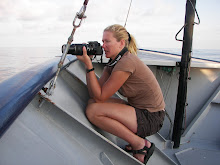Today we continued to work on samples collected from an experiment we began 2 days ago. Since our previous sampling sites were covered in ice and did not contain enough phytoplankton to conduct our originally-planned experiments, our chief scientist developed an alternative experiment using the algae that develops on the underside of the ice, known as“ice algae”.
As seawater freezes, only the water fraction is converted into ice, while the salts and other elements leach out into the surrounding water as salty brine. In addition to salt, this brine contains nutrients which phytoplankton require to photosynthesize and grow. Sunlight penetrates through the ice and provides the energy for ice algae to convert carbon dioxide and water into oxygen and carbohydrates.
These algae in turn are an important food source for small microscopic grazers, such as krill. Krill also benefit from the shelter the ‘nooks and crannies’ within the ice provides. Antarctic krill species can live up to 7 years and depend upon the ice cover and ice algae to nourish and protect them, respectively, during this time. Infact, years of low ice coverage have been shown to coincide with years of low krill ‘recruitment’ (the resupply of the next generation). Even penguins and seals depend upon these ice floes for the animals (especially krill and small fish) which inhabit and feed within the small crevices within the ice. For our experiments, we collected‘dirty ice’ (ice containing an abundance of algae, which stains it brown or yellow) by zodiac and water samples using special machinery onboard the ship.
The water samples were run through a series of filters, to establish different size fractions to exclude certain types of zooplankton. Then we added copepods (crustaceous zooplankton) to several experimental containers to determine the impact these grazers have on the microbial community.
The experiments are being conducted in a walk-in freezer set at 0°Celcius for 72 hours. In the meantime, we continue to steam south towards Terra Nova Bay, a relatively ice-free region where we expect to find an abundance of phytoplankton, and where we will conduct our originally-planned experiments.
The waters of Terra Nova Bay are naturally nutrient-rich and support large, ‘juicy’ phytoplankton, which serve as prey for large zooplankton such as krill, which themselves are food for migrating whales, seals and penguins. As such, I had my first whale sighting today –a pod of Antarctic Minke whales! I am hopeful that there will be many more to come in the days ahead.
Monday, January 21, 2008
Subscribe to:
Post Comments (Atom)
.jpg)





No comments:
Post a Comment